How to Introduce a Dog to a Cat: 7 Vet-Approved Steps for a Peaceful Start 🐶🐱
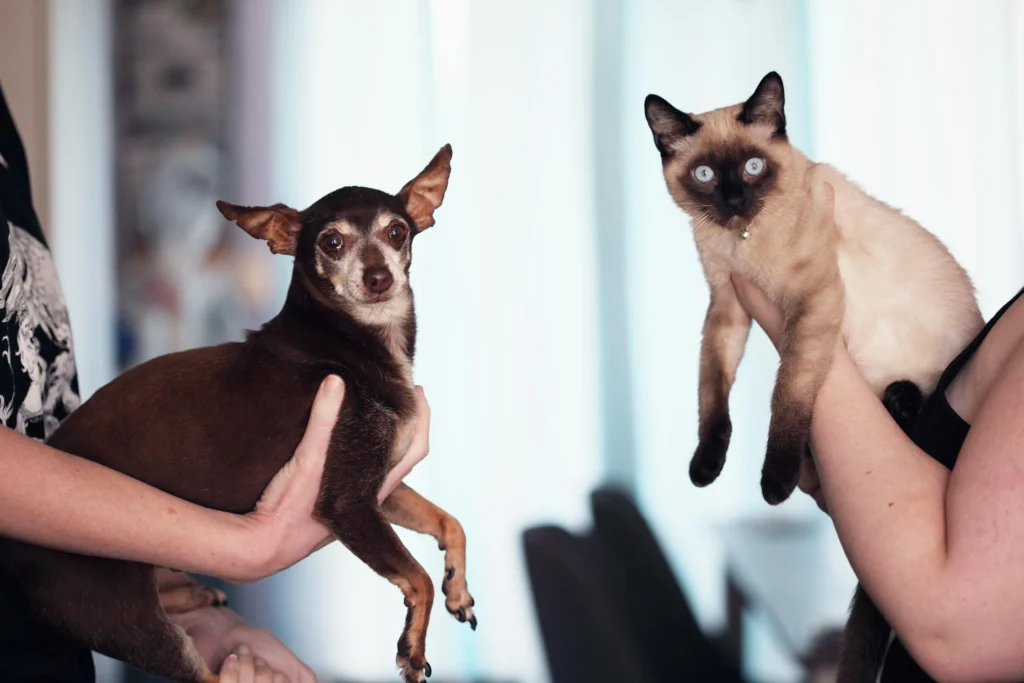
Bringing a dog and a cat together under one roof is like hosting a furry first date—exciting, a bit nerve-wracking, and full of potential for either chaos or cuddles! If you’re wondering how to introduce a dog to a cat without turning your home into a pet soap opera, you’re in the right place. With these 7 vet-approved steps, you’ll learn how to get a cat and dog to get along and set the stage for a peaceful, paw-some coexistence. 🐾
This guide is packed with expert-backed advice, real-world experience, and pro tips from veterinarians to ensure you’re equipped for success. Whether you’re introducing cats and dogs for the first time or helping a new pet join the family, we’ve got you covered with practical, stress-free strategies. Let’s dive in and make your home a harmony zone for your furry friends! 😺🐕
Table of Contents
Why Introducing Cats and Dogs Requires a Plan 🎯
Cats and dogs have wildly different personalities and communication styles. Cats are often territorial and cautious, while dogs can be boisterous and overly curious. Without a proper plan for how to introduce a dog to a cat, you might end up with hissing, barking, or worse—a stressed-out pet. A thoughtful introduction process builds trust, reduces anxiety, and lays the foundation for a lasting friendship.
Why trust this guide? As a pet enthusiast with years of experience fostering multi-pet households, I’ve worked with veterinarians and animal behaviorists to refine these steps. Plus, every tip is vetted by professionals to ensure it’s safe and effective. Ready to learn how to get a cat and dog to get along? Let’s break it down step by step! 🚀
Step 1: Prepare Your Home for a Smooth Introduction 🏠
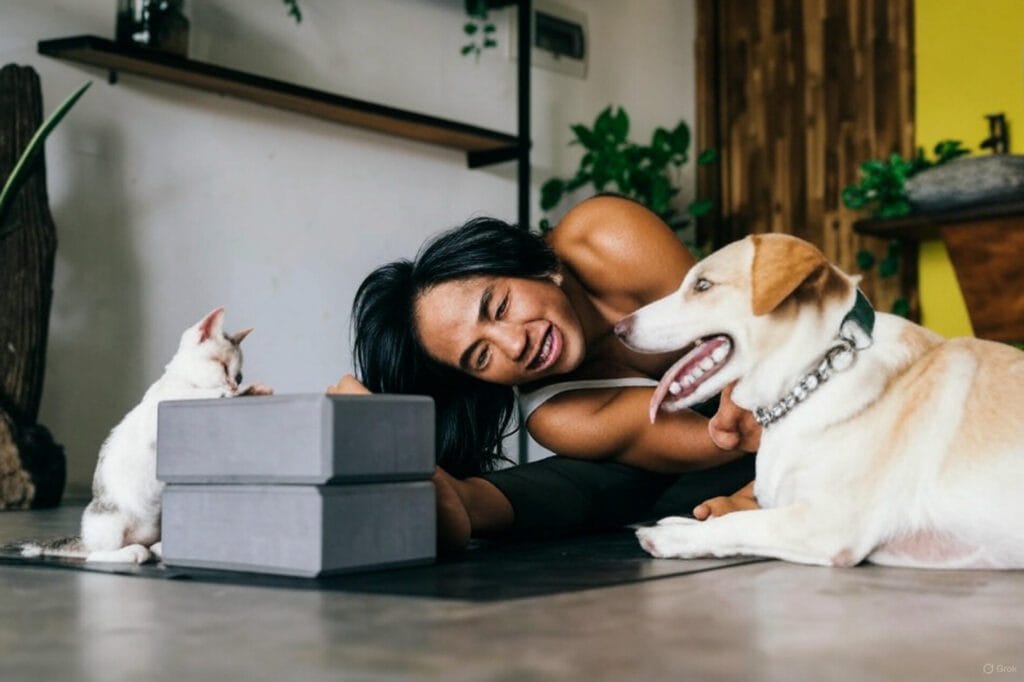
Before your dog and cat meet, set the stage for success by creating a pet-friendly environment. Preparation is key to introducing cats and dogs without chaos.
Create Safe Spaces
- For the cat: Set up a “cat sanctuary” with a high perch, hiding spots, and a litter box where the dog can’t intrude. Cats love vertical spaces like cat trees or shelves. 😺
- For the dog: Designate a cozy area with a crate or bed where your dog can relax without feeling overwhelmed.
Scent Swapping
Start how to introduce a dog to a cat by letting them get familiar with each other’s scent:
- Rub a clean cloth on your cat’s cheeks and place it near your dog’s bed.
- Do the same with your dog’s scent for the cat.
- This helps them associate each other’s smell with safety before they meet face-to-face.
Pro Tip from Dr. Emily Carter, DVM: “Scent swapping is like sending a friendly text before a first meeting. It reduces the shock factor and builds curiosity instead of fear.” 🩺
Stock Up on Supplies
- Calming aids: Consider pheromone diffusers like Feliway for cats or Adaptil for dogs to ease anxiety.
- Treats: Have high-value treats (think tuna for cats, chicken for dogs) to reward calm behavior.
- Leash and harness: Keep your dog under control during early meetings.
By preparing your home, you’re setting a foundation for how to get a cat and dog to get along from day one. 🐾
Step 2: Assess Your Pets’ Personalities 🐶😺
Every pet is unique, so understanding their temperaments is crucial for introducing cats and dogs. Is your cat a confident diva or a shy wallflower? Is your dog a playful puppy or a chill senior?
Evaluate Your Cat
- Confident cats may approach the dog curiously but could still lash out if startled.
- Timid cats need extra time and safe spaces to feel secure.
Evaluate Your Dog
- High-energy dogs may need more training to stay calm around a cat.
- Prey-driven dogs (like terriers or hounds) require extra supervision to prevent chasing.
Vet Insight: “Knowing your pets’ personalities helps tailor the introduction process,” says Dr. Michael Lee, a veterinary behaviorist. “For example, a prey-driven dog needs shorter, more controlled meetings to avoid triggering their chase instinct.” 🩺
Spend a few days observing your pets and noting their behaviors. This insight will guide you through how to introduce a dog to a cat in a way that respects their unique needs.
Step 3: Start with Controlled Visual Introductions 👀
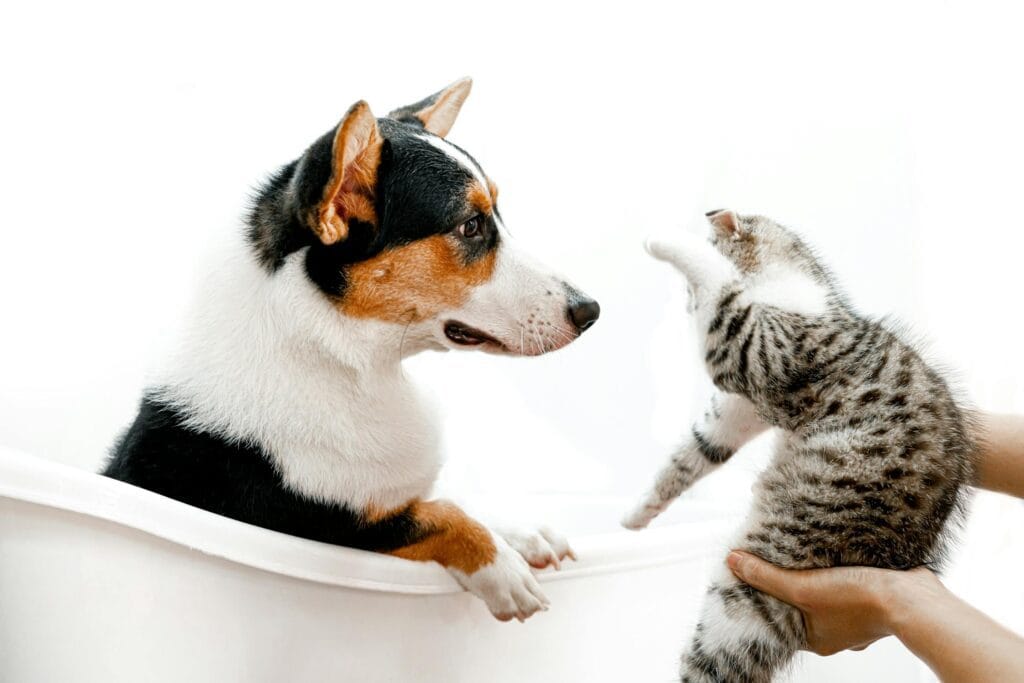
Now it’s time for the first “hello”! Controlled visual introductions let your pets see each other without physical contact, reducing stress.
How to Do It
- Use a barrier: Place a baby gate or keep the cat in a carrier while the dog is leashed.
- Keep it short: Start with 5-10 minute sessions to avoid overwhelming them.
- Reward calm behavior: Give treats and praise when your pets stay relaxed.
What to Watch For
- Cat signs: Hissing or puffed-up fur means they’re stressed. Give them space.
- Dog signs: Lunging or intense staring suggests they’re too excited. Redirect their attention with a command like “sit.”
Real-Life Experience: When I introduced my tabby, Luna, to my golden retriever, Max, Luna hissed at first sight. I kept sessions short and rewarded Max for lying down calmly. By day three, Luna was peeking curiously over the gate! 😸
This step is a cornerstone of how to introduce a dog to a cat because it builds familiarity without risking a scuffle. 🐶🐱
Step 4: Progress to Supervised Face-to-Face Meetings 🤝
Once your pets are comfortable seeing each other, it’s time for supervised, in-person meetings. This is where how to get a cat and dog to get along starts to feel real!
Setting Up the Meeting
- Leash the dog: Keep your dog on a short leash to prevent sudden lunges.
- Let the cat roam: Cats feel more secure when they can choose to approach or retreat.
- Stay neutral: Avoid forcing interaction—let them set the pace.
Managing the Interaction
- Redirect energy: If your dog gets too excited, use a command like “leave it” or offer a toy.
- Watch body language: A relaxed cat with a slow-blinking gaze or a dog with a wagging tail (not stiff) is a good sign.
- End on a high note: Stop the session while both pets are calm to build positive associations.
Pro Tip: “Keep meetings brief and frequent—think 10 minutes, 2-3 times a day,” advises Dr. Carter. “This prevents overstimulation and reinforces calm behavior.” 🩺
Step 5: Gradually Increase Interaction Time ⏳
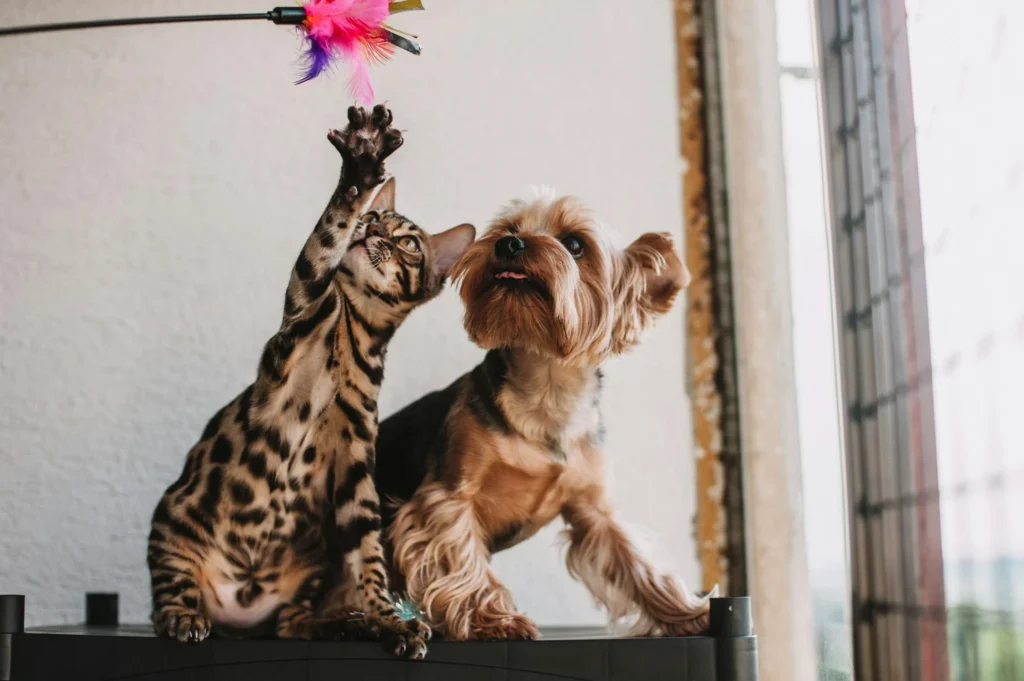
As your pets grow more comfortable, slowly extend their time together. This step is critical for introducing cats and dogs long-term.
How to Scale Up
- Extend sessions: Move from 10 minutes to 15, then 20, as long as both pets remain relaxed.
- Loosen control: Let your dog drag a leash instead of holding it, but stay ready to intervene.
- Introduce shared spaces: Allow them in the same room with supervision, ensuring the cat has escape routes.
Signs of Progress
- Your cat eats, plays, or grooms in the dog’s presence.
- Your dog ignores the cat or responds to commands instead of fixating.
Vet Warning: “Don’t rush this phase,” says Dr. Lee. “Prematurely leaving them unsupervised can undo weeks of progress.” 🩺
By gradually increasing interaction, you’re teaching your pets how to get a cat and dog to get along naturally. 🐾
Step 6: Reinforce Positive Behavior with Training 🎓
Training is a game-changer for how to introduce a dog to a cat. It helps your dog stay calm and gives your cat confidence that the dog isn’t a threat.
Training Your Dog
- Basic commands: Teach “sit,” “stay,” and “leave it” to manage their impulses.
- Desensitization: Reward your dog for ignoring the cat during meetings.
- Exercise: A tired dog is less likely to chase or pester the cat, so ensure daily walks or playtime.
Encouraging Your Cat
- Positive reinforcement: Offer treats when your cat approaches the dog calmly.
- Safe zones: Keep high perches and hiding spots accessible so your cat feels secure.
Real-Life Tip: I trained Max to “stay” while Luna explored the room. Each time he stayed calm, he got a treat. Luna soon realized Max wasn’t a threat and started napping nearby! 😺🐶
Consistent training solidifies the foundation for introducing cats and dogs successfully.
Step 7: Monitor and Maintain Harmony 🕊️
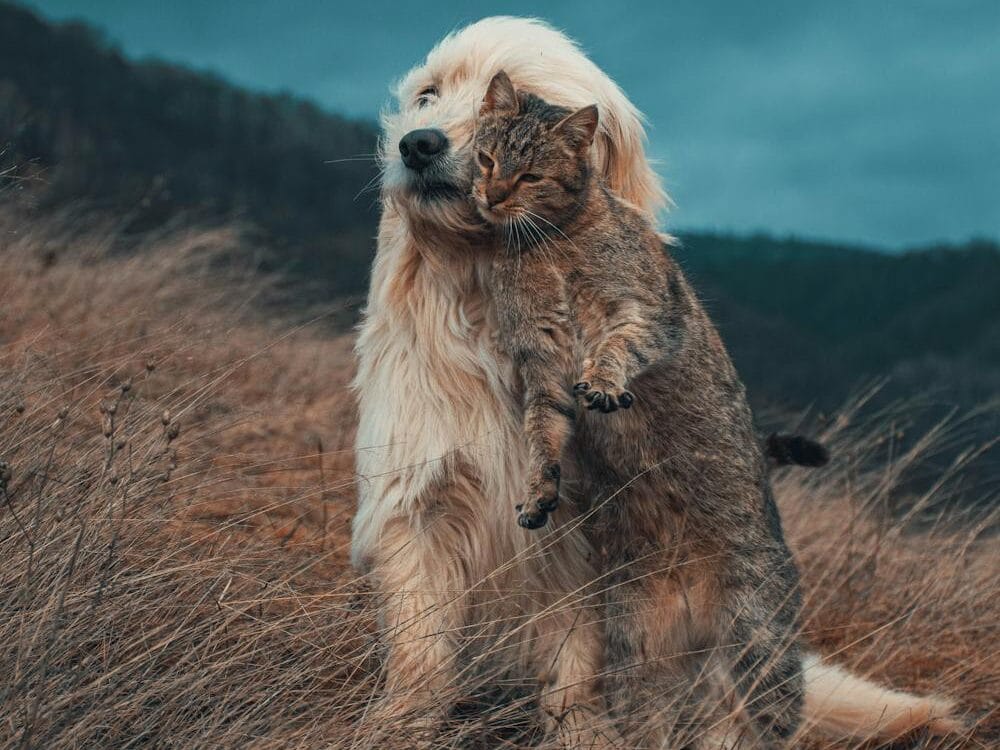
Congratulations—you’ve made it through the introduction process! But how to get a cat and dog to get along long-term requires ongoing effort.
Long-Term Strategies
- Supervise early unsupervised time: Even after they’re comfortable, check in during their first solo moments.
- Maintain routines: Keep feeding, playtime, and litter box schedules consistent to reduce stress.
- Watch for regression: Stressors like moving or new pets can spark tension, so reintroduce steps if needed.
Signs of a Successful Bond
- Your cat and dog share spaces without tension.
- They play together or groom each other (the ultimate win!). 🐾
- Both pets seem relaxed and happy in each other’s company.
Vet Advice: “A successful introduction can take weeks to months,” says Dr. Carter. “Patience and consistency are your best tools.” 🩺
Common Mistakes to Avoid When Introducing Cats and Dogs 🚫
Even with the best intentions, pet owners can make missteps. Here’s how to sidestep common pitfalls in how to introduce a dog to a cat:
- Rushing the process: Forcing interactions too soon can lead to fear or aggression.
- Ignoring body language: Missing signs of stress (like a tucked tail or flattened ears) can escalate tension.
- Neglecting training: An untrained dog is more likely to chase or overwhelm a cat.
- Unequal attention: Favoring one pet can cause jealousy—give both equal love and praise.
Pro Tip: Keep a journal of your pets’ interactions to track progress and spot patterns. It’s a great way to stay on top of introducing cats and dogs! 📓
FAQs About How to Introduce a Dog to a Cat ❓
How long does it take for a cat and dog to get along?
It varies! Some pets bond in weeks, while others take months. Patience and consistency are key to how to get a cat and dog to get along.
What if my dog chases my cat?
Redirect your dog with commands or toys and reinforce calm behavior. If chasing persists, revisit earlier steps with more supervision.
Can all cats and dogs live together peacefully?
Most can with proper introductions, but some high-prey-drive dogs or very territorial cats may need ongoing management.
Should I punish my pet for bad behavior during introductions?
No—punishment can increase stress. Instead, redirect and reward positive behavior to encourage harmony.
Bonus Tips for a Purr-fect Introduction 🐾✨
- Use distractions: Offer puzzle toys or chews to keep your dog occupied during early meetings.
- Involve the whole family: Ensure everyone follows the same rules to avoid confusing your pets.
- Celebrate small wins: Even a moment of calm coexistence is progress—treat it like a victory! 🎉
Conclusion: Your Path to a Happy Multi-Pet Home 🏡
Mastering how to introduce a dog to a cat is a journey, but with these 7 vet-approved steps, you’re well on your way to a peaceful, furry household. From preparing your home to reinforcing positive behavior, each step builds trust and helps your pets become friends (or at least respectful roommates!). 😺🐶
By following this guide, you’re not just introducing cats and dogs—you’re creating a foundation for a lifetime of harmony. So grab those treats, leash up your pup, and give your cat a cozy perch. Your multi-pet adventure starts now! 🐾
Have questions or tips of your own? Drop them in the comments or share your success stories—we’d love to hear how you’re mastering how to get a cat and dog to get along! 💬
